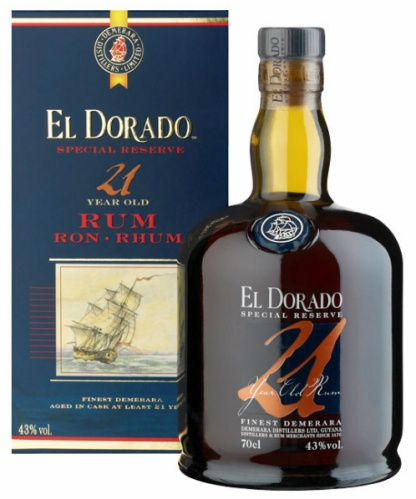After reviewing the 12yo (in 2013) and the 15yo (in 2015) from the El Dorado premium range, now the time has come to move up one step of the ladder again and have a look at the 21yo. Just like it’s two younger brothers it has been blended together from Rums made with several of the many stills that have survived. I call the three, “brothers”, since the three aren’t simply older versions of the same kid, but the DNA between the three has some variation. Related but different, like brothers. This 21yo has been blended together from the Albion (AN), a French Savalle still, the Versailles (VSG), a single wooden pot still and the Enmore (EHP), a wooden Coffey still. Where in the 21yo, the Albion is the dominant one.
I have read somewhere that, 35yo Rum was used, but by now, because the 21yo is around for some while, that might not be the case anymore. I’m sure the Rums used, have different vintages where the youngest Rum has to be 21yo. A rule adopted, from Single Malt Whisky, by the English-speaking Rum world. This is completely different from the practices of Solera type Rums. The Rum has aged exclusively in the carribean and since the climate is hot and dry, Rums this age can get very easily over-oaked, since water, instead of alcohol, is the first to evaporate. Speeding up the ageing process, as compared to the more mild European climate. Cadenheads and Bristol come to mind, when thinking about Demerara Rums that have (partly) aged in Europe, but there are many others.
 Color: Copper gold.
Color: Copper gold.
Nose: Thick Demerara style. But with a breath of fresh air. Sharp wood, spicy wood. Tar and oak. Lovely. This is how a Rum should smell, one that has been in cask for a long time. Are you paying attention Don Papa? Oh, wait a minute. Caramel and toffee comes next. Somehow the nose seems glued together with sweetness now. Hints of petrol and melting plastic to balance things out. Yes again an aroma that sounds hideous, but really isn’t. Well it is, but not in this Rum. Dry crushed leaves and molasses with a return to the more woody notes. Green and (dry) grassy. Hints of lavas, but darker and more brooding. Tar covered lavas then? Black tea and hot toffee (again, slightly deep burnt sugar-toffee). Dry, dusty and now I get more than a fair share of licorice (and warm caramel), whilst I revert to smelling it like a Dyson would. Vortex snorting. (I must remember this expression, and use it more often, since it is revealing). Nice stuff. I have a feeling there is some fruit to it as well, but since the Demerara style is strict and fierce it doesn’t let it out. Very appetizing but also I fear some added sugar was used on this old Rum. Let’s taste it.
Taste: Thick (for a brief moment) and sweet, but not too much, and never cloying. Lots of licorice again, but also a slight nudge towards the style of Agricole. Unmistakable, I get it every time. Excellent aged brown sugar aroma, but with lots of soft wood notes to balance this out. A nice burnt (sugar) note, toasted oak with vanilla, combined with bitter oranges. Cold black tea and ear wax, but with less bitterness than both. This one is about wood. So here the number 21 does mean age. Very balanced, it tastes exactly like it smells, less sweet maybe and “thinner” in structure. Since this is an old one, because in Caribbean weather, 21 years in wood is almost a lifetime, the sweetness is broken down and surpassed by the effect the wood has on this Rum. Hints of freshly sawn oak even. It’s not as big and shows some delicacy of the old, especially towards the finish. In the finish some soapy and definitely bitter wood stay behind and some honey as well. The aroma’s are brittle and hardly a problem though.
This is geriatric Rum, I love it, sure in many ways it is over the top, as if aged for too long, gaining too much of the benefits of wood, making it less easily drinkable, than the very sweet 12yo and the very nice 15yo. This is why of the whole series people tend to prefer the 15yo as a sipper, and the 8yo as a daily drinker. But this 21yo has its moments and when it time, this delivers, warts and all. Granted this may be for experienced drinkers to really appreciate it, and so be it. If you are not one of those, you might want to stay off this one for a while for you to become of age and try it again. And if you do, it will be clear this was (today), fairly priced as well.
Points: 87
 Color: Copper gold, with a pinkish hue.
Color: Copper gold, with a pinkish hue. Color: Full gold.
Color: Full gold. Color: Full gold.
Color: Full gold. Color: Full gold.
Color: Full gold. Color: orange Brown.
Color: orange Brown. Color: Gold.
Color: Gold. Color: Light gold. The color of this one is ever so slightly lighter than cask #467.
Color: Light gold. The color of this one is ever so slightly lighter than cask #467. Color: Mahogany brown.
Color: Mahogany brown. Color: Orange gold.
Color: Orange gold.